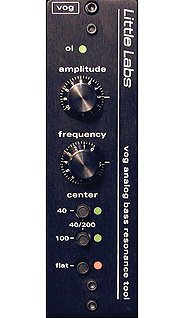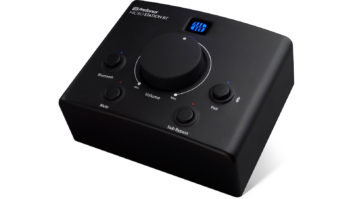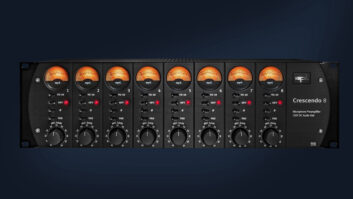
VOG’s controls comprise gain and sweep rotary pots, and frequency choice buttons.
Jonathan Little, the brains behind Little Labs, has a knack for creating sonic tools that solve problems in unique ways—such as his IBP Phase-Alignment Tool, the PCP Instrument Distro and the Lmnopre mic preamp—and provide engineers with better ways of doing high-quality work. The VOG Bass Resonance Tool, Little Labs’ latest creation and the company’s first 50 Series rack unit, was unveiled at this past fall’s AES show and is now shipping.
VOG’s creation stems from Little’s fascination with design errors in circuits and transformers. For example, when winding step-up transformers, he found—by accident—that he would occasionally encounter one that exhibited a very deep and narrow notch in the frequency response. He discovered the VOG in a similar way, and it’s very good at what it does. Its sole purpose is simple: to beautify the bottom end of selected instruments by letting you dial in clean, musical gain in a narrow resonant peak at your choice of frequencies between 20 and 300 Hz. At the same time, anything below that peak value is rolled off at a steep -24dB per octave to reduce low-end mush.
LITTLE VOICE
The front panel knobs and buttons are solid and clearly laid out, making it easy to get a grasp on the VOG’s operation. The rotary Amplitude knob offers gain control from no gain (0) to +18 dB (10). There is a relay at the “10” position that offers the last bit of gain up to maximum. The Frequency knob provides variable frequency control, which at its “5” position is aligned with the three center position switches. For instance, if you push the 40 button, the center frequency at “5” on the Frequency knob is 40 Hz, and so on. The first two buttons represent 40 Hz, 100 Hz and 200 Hz (both down). The last button is marked Flat. This soft bypass allows you to audition the effect of the unit without a change in gain.
The VOG runs balanced signal throughout, which not only offers sonic advantages over a balanced/unbalanced/balanced internal signal path, but also allows the unit to be used in mono (balanced) or stereo (unbalanced). Stereo operation is accomplished by wiring pin 1 to ground, pin 2 left and pin 3 right on the XLRs. Although I never used it in this fashion, this handy tip gives this pony an added trick.
I used VOG on a variety of sessions, both on kick drum and bass with great results. Operation is incredibly simple and you have to hear this thing to grasp how brilliant it is. Dialing in the body in a kick—even a drab one—is as easy as selecting the 40 button, boosting gain to 10 and tuning in the booty with the frequency control. It’s just as good on bass. I pressed the 100 button and used the same method to bring the bass right out of the mud and into the mix.
Even at maximum gain, the way the VOG boosts and cuts frequencies is very musical. Below the boost frequency, the gain falls off drastically at 24dB per octave. Above the boost frequency, the fall-off is more gradual and then razor-flat. We ran a number of bench tests including boosting the gain until the red overload light was lit. Even then, the distortion numbers were still amazingly low. This box offers a ton of headroom and sounded clean no matter where we used it.
VOG IS GOOD
On bass and low drums, the VOG is brilliant. The unit’s layout couldn’t be easier. The buttons are well marked, making it easy to choose your frequency range broadly, and then use the top knob for gain and the bottom for tuning in the frequency you want to boost. The only thing I didn’t like? The frequency control seems counterintuitive, with the higher frequencies represented by the lower-numbered, counter-clockwise turn of the dial, and vice versa for the lower tones. To put it in Spinal Tap terms, 11 is lower, which seemed strange to me. That, however, is easy to get used to because the VOG works best when you don’t think about its operation, but instead use your ears to find the tone you’re looking for. It is mindlessly intuitive and keeps your ears on the audio. Highly recommended.
Kevin Becka is
Mix
’s technical editor.

Click on the Product Summary box to view the Little Labs VOG product page.







